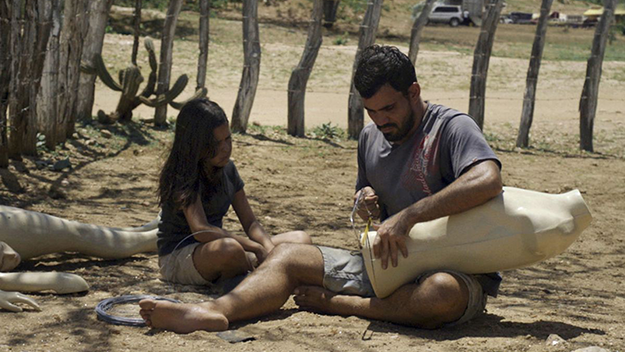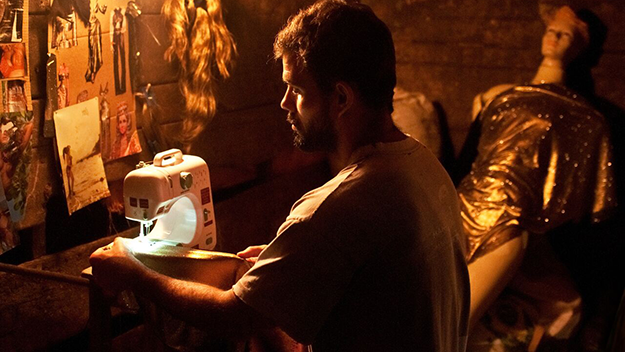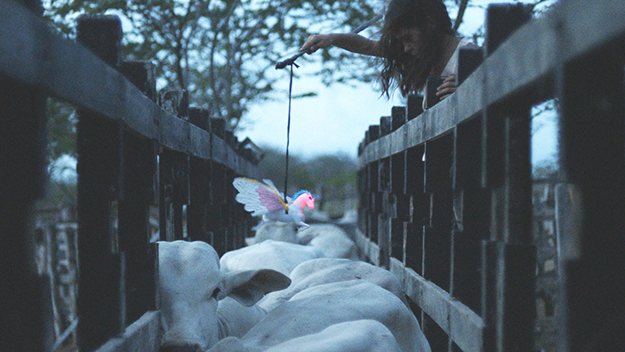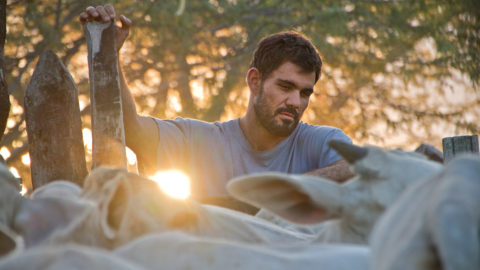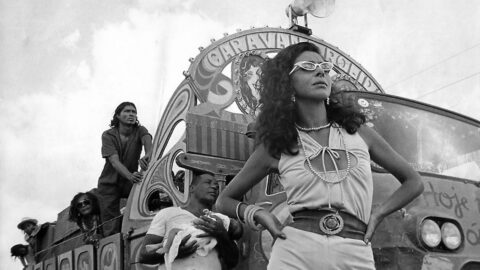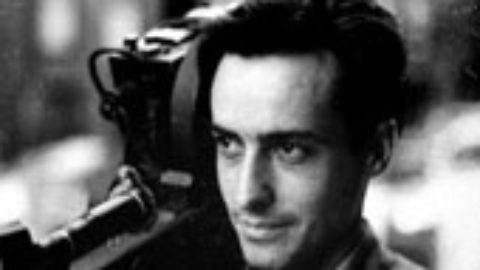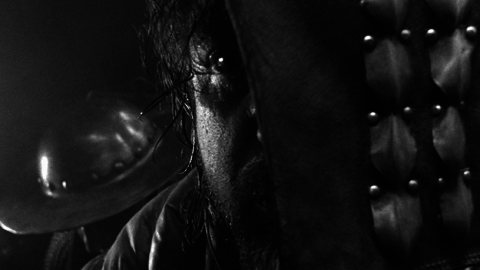Interview: Gabriel Mascaro
Perhaps it’s because it’s become a dominant aesthetic in contemporary art house cinema, but there’s something about Neon Bull’s slow, unassuming style that seems to suggest a lengthy workshop process with nonprofessional actors, whose spontaneous movements have been documented by a vigilant cameraperson. Yet this is simply not the case: the film’s actors are household names in Brazil, and everything was scripted. The effortlessness of Mascaro’s approach no doubt comes from years honing his craft in non-fiction works such as High-Rise (09), a documentary about penthouse residents in Recife, Rio de Janeiro, and São Paulo (whose subjects put limitations on how long and what he could film, which forced him to come up with artful workarounds), as well as video art pieces like Não é sobre sapatos (It Is Not Just Shoes, 14), which follows the 2013 protests against the increase in public transportation fares and police brutality; both successfully use the specific to touch on larger issues of wealth and fear in Brazil.
Like his previous fiction film, August Winds (14), Neon Bull is set in Brazil’s Northeast, a historically impoverished area of the country that has figured prominently into its culture, be it in Bahian sambas or in the imaginations of writers and filmmakers like Oswald de Andrade or Glauber Rocha. Playing on notions of what the area is, Neon Bull follows Iremar (Juliano Cazarré), a cowboy with a traveling vaquejada (traditional rodeo) who designs women’s clothing in his spare time; while on the road, he alternately bonds and feuds with Galega (Maeve Jinkings) and her precocious, put-upon daughter Cacá (Alyne Santana). Subverting numerous expectations about gender, sexuality, and bodies, it’s a film that reflects the changes in the region, and complicates it in the popular imagination. FILM COMMENT spoke with Mascaro shortly before Neon Bull screened at New Directors / New Films; “Gabriel Mascaro: Ebbs and Flows,” a retrospective of his films, runs April 15 – 21 at the Film Society of Lincoln Center.
In August Winds, you had only one professional actor, whereas in Neon Bull you used all professional actors. Can you talk about the process of working with them, because they move very naturalistically in the frame and really seem like non-professionals?
It was difficult to get these performances, which required the actors to totally forget the whole preparation behind the scenes in order to make the film feel very naturalistic, powerful, real, and unique. But beyond the idea of naturalism, I prefer to talk about how it’s very unique and magical. About how the actors, through the camera movements and the whole experience, had some great ideas and did unique and intense things that were unrepeatable. Of course, the film was scripted and the actors had some dialogue and all these classical elements of filmmaking, but the way we created the camera movements, the experience of acting, and even the presence of the animals, created a total displacement that helped the actors go beyond their own limits. The performances really depended on a group effort, and the Iremar character really needed space to breathe in order to let the reality come in and become part of the performance.
Neon Bull also works with a performance style that doesn’t only involve talking but also silences, listening to each other—so these are all important elements of the performance. I told the little girl who played Cacá, “If you don’t want to speak, don’t say anything. Just breathe and stay silent.” There are many moments in the film where she’s about to say something and she waits and says it later. Those are really strong moments in the film. For me, the most beautiful moments of the film are Cacá’s silences, when she waits until she believes in what she is trying to say.
Did you let the actors go wherever they wanted to in the frame and moved the camera in response, or did you have the movements blocked out beforehand?
The film has several paradoxes in it. For instance, I constructed a sense of intimacy by not getting close to the bodies. It was very interesting to realize that the further you step back, the closer you get to the character internally, the more space and power you give them. The camera movements were very precise and drawn out, because the camera was only making minimal movements—you don’t perceive a lot of the camera movements in the film. When you do perceive one, it’s very subtle. The camera never puts something in your face: it has its own bodily experience. Because the film has very complex camera movements, there were limits to what we could have the actors do inside the frame. And because of the slow pacing of scenes, it created this illusion that everything was very free and open, but in reality they were very choreographed. It also created an illusion that everything was really happening. The sex scene lasts seven minutes without a cut; another scene with Iremar and Cacá, where he sews something on the mannequin and then hugs her, lasts five minutes without cuts. This disorients our distinction between fiction and performance.
The dialogue isn’t really loaded with narrative meaning; it’s not really telling the story or explaining what’s happening. These exchanges exist at the level of the reality of the characters’ daily lives. It’s almost as if the camera were trying to replicate their life experience. That’s another thing that creates the element of naturalism in the film. It’s not dialogue that’s at the service of the narrative. It’s not trying to move the narrative forward. The film creates an ambiguous relationship with the narrative by breaking expectations and not through the existential transformation of the characters. The film favors small gestures that take place in the daily life of the characters during small moments. It uses the vaquejada as an allegory of this moment in Brazil with all the paradoxical elements that come with both.
I was reminded of Carlos Diegues’s Bye Bye Brazil while watching this. The characters in that film are also driving all around the Northeast, and the film shows how things are changing very radically in the region—some things for the better, some things maybe not. Could you speak to whether that was in your head when you were making Neon Bull?
There’s a natural connection between this film and Bye Bye Brazil, but it wasn’t necessarily my point of reference. I understand it and I think there are possible connections to be made between these two films. I think in some way Neon Bull deals with this contemporary Brazil that has developed very recently and very fast, and it deals with how that’s affecting human relationships—especially in this place that used to be very agricultural and had other kinds of values, and has now changed a lot. But we didn’t try to create some kind of nostalgia for the past or tried to say, “Oh, in the past, people were more like this or that.” It wasn’t a naïve approach—I tried to deal with the contemporary situation in the region and make a statement about the complexity and ambiguity that most of us face. For example, we have all these new perspectives into these characters’ day-to-day lives, and I tried to expand the notion of gendered identities and create these cowboys who are facing different kinds of sensibilities and create a contrast between the “real” reality of the region and this suspended reality in the film.
In regard to playing with these gender dynamics, why did you choose fashion design out of anything for Iremar to do in his free time?
It’s really interesting: the Northeast of Brazil has now developed a whole clothing industry where they’re creating surfing fashion in the middle of the desert, in a place where there’s basically no water. And even more fascinating is that the farmers and people who live there have started wearing these clothes—they’ve developed a relationship with this industry. As I was researching the film, I actually found a cowboy who worked in a clothing factory. I was trying to approach this universe, which at first seemed far away from here because of its sexist culture and its violence, but through this character who has other interests, I was able to find a way into this culture of the cowboy and to get emotionally involved with this world that could also be mine. The directing and the camera movements don’t really try to judge the characters, nor does the editing try to manipulate an emotion out of the viewers—not even the characters try to judge one another. This begs the question: how do you make a film without conflict and judgments? [Laughs] The film establishes conflict by juxtaposing our expectations with what’s happening in the film. So, for instance, there’s a scene where Junior [Vinícius de Oliveira] spends a lot of time fixing his hair. It’s a scene where the audience usually laughs. But later on, Galega, the character played by Maeve Jinkings, really admires him and is really attracted to him. So that’s a conflict that I was interested in developing. The film works through ambiguity and expectations. For instance, that scene where Iremar is walking through the field with all the colors, is at first very beautiful. But later on you realize that it’s actually a trash field. Without changing the framing or the way the scene is shot, the film slowly changes our perception of the frame and of the film itself.
Mentioning the hair straightening scene, I think there are little moments where, in addition to the commentary on gender, there’s some commentary on race. But it’s very subtle and in that way it reminded me a little bit of Iracema—Uma Transa Amazônica, which also documented a truck journey across the Northeast. Did you draw from that as well?
I love Iracema, it’s one of my big influences. It’s one of the best Brazilian movies ever. And yes, I think there are plenty of social elements in the film and multiple layers that the space and the human landscapes create. For me, it’s much more a film about human landscapes—where humans impacted the environment, and how those interventions created new relationships between people. I also like when Cacá asks Galega about her curly hair, and Galega’s [not negative] answer upends the girl’s expectations. That could also be our expectations associated with the little girl’s perspective.
With your previous feature, you were the cinematographer as well, but here you worked with Diego Garcia. How did you communicate with him and what was that collaboration like?
It was a very magical encounter that was made possible through a co-production with the Uruguayan producer. The producer was living in Mexico at the time. I wanted to focus on the work with the actors and not focus on the camera, so we found Diego. He actually came to the city where we were filming a month before the shoot started, and we had lots of conversations about lenses and the look of the film. It was a very generous contribution to the finished product. Diego had already done some very interesting work. He hadn’t done the Apichatpong film yet—he went from the Brazilian Northeast to Thailand to shoot Cemetery of Splendor afterward. I had seen some of his video art where he had lit the bodies of his subjects in very interesting ways, which was useful for the scene with the horse in Neon Bull. I found many similarities between our work.
It was very important for me to make the actors feel comfortable while we were shooting, and to have the lighting make them comfortable. I wouldn’t have been able to make this film on my own because there are scenes that require the actors to fully give their bodies, like the sex scenes, for example. There was a moment during filming when the actors were actually very afraid of doing the sex scene, so I decided to shoot the scene of the naked men taking a shower first. After that, they actually became very excited to shoot the sex scene because they realized the aesthetic and the way the film was going to capture those scenes. When Samya [De Lavor] and Juliano saw the shower scene, they said: “Now we want to have sex! Now we want to be in that beautiful light.” They were really inspired by that.
The way that scene disrupts the narrative is very similar to how the sex scene in August Winds just stops everything. What really defines the film for me is this approach to sexuality, just how reverential and beautiful it is, and that it is a very pregnant woman who is being pleasured. That’s not an image you see in 99 percent of films.
It’s interesting because there’s a discussion even before one gets to that: a discussion of the body in the cinema, and how to look at the body in cinema. And how to approach and back away from the body: what’s the distance between the camera and the body? Throughout the history of cinema we’ve been losing elements of the rituals of the body because they didn’t add dramatic elements to cinema. I’ve been trying to recuperate these rituals of the body, the experience of the body. That’s why we have a very bold scene with a pregnant woman. We also have a scene where a man is urinating, which is something rarely seen as well. So those oddities can also be brought back to the realm of the normal. The audience actually goes in and out of that scene where Iremar is having sex with the pregnant woman several times. By that I mean that the audience is thinking: “Is she really pregnant? How crazy is this? And this actress’s husband, what is he thinking?”—of course, no one asks about the actor’s wife, because there’s this sexist culture in Brazil—and at some point, you sort of stop finding it strange and you start enjoying it with the actors. It’s the same thing with the scene where the man is urinating. I find it strange that it’s so avoided in cinema and especially when it comes to men. So we have a lot of situations where urine is used sort of like excrement, something that needs to be thrown away, but rarely in this kind of more organic, natural way. I’m speaking in the field of pleasure and sex but also thinking of the body and things that are often left off frame. “A struggle of spaces,” you could say: a body that struggles for space, that is asking for space.
You know, I made a film in the world of vaquejadas: it’s very sexist and, in a way, these characters are completely detached from their world. They are very fictionalized in that respect. But they’re also very believable because even though they are sort of not connected with these kinds of sexist aspects of the vaquejada, they also feel very real and I think people believe in them as they’re watching the film.
What you’ve said about bodies is a form of provocation, and I think even setting the film in the Northeast—among very poor people who are transient—is sort of a political act.
In the history of Brazilian literature and arts, the Northeast is always portrayed as a place that people want to get away from, that people want to escape from. And a lot of people did leave, but my generation of filmmakers and artists has decided to stay. I wanted to make a road movie where people weren’t going away but weren’t actually staying in the Northeast. There’s almost like a cyclical movement in this road movie. The idea of the road movie here is more about how to transform that desire: the characters don’t want to go away; they want to transform the place they are in, together. It’s not a film about a poor and isolated place, but a film about a place in transformation. There’s something very contemporary about them wanting to be connected with the outside and not being isolated.
So, like August Winds, even though people were in these isolated places that present challenges in terms of how they could interact with the world, they were also connected with the outside world, with global culture, and pop music and all those elements. The idea was to make a film where you’re not feeling pity for the characters. Or guilt. The characters are not naïve either.
Do you feel that this is in and of itself a challenge or sort of a provocation to what’s come before? Or at least to the way things exist now in Brazil’s current media landscape? Because I think if you look back to Cinema Novo there was very much an engagement with the culture of the Northeast.
You’re right, there’s a second moment of approaching and representing the Northeast, where in a way the Northeast has been represented as the place that would fix or repair the modern identity crisis of the bigger cities in Brazil. A sort of Maoist idea ran through the Cinema Novo films where you could transform the urban centers through a rural revolution. And, in a way, the characters are turned into allegories and they become characters that are brave and courageous and preserve the ideals of the country. In Neon Bull, I’m sort of modernizing that idea. I can’t look at people as museums, as people who are preserving national roots because the roots are changing all the time. I was a lot more interested in human beings in an ordinary way, not as the people who would preserve the history of Brazil or sort of recuperate this notion of identity. Before, the Northeastern people were used in that way, as sort of an allegory of this true Brazil. The people in my film are building new identities. They are transforming the body and the place where they live.
Thanks to Rodrigo Brandão for his live translation, and to Michael Gibbons for additional assistance.



